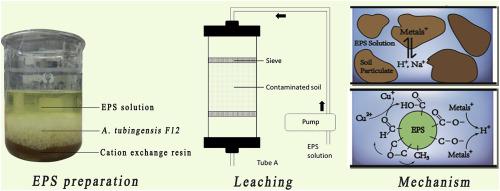Chemosphere ( IF 8.1 ) Pub Date : 2020-08-05 , DOI: 10.1016/j.chemosphere.2020.127883 Aixing Tang 1 , Yuhao Lu 2 , Qingyun Li 1 , Xianglu Zhang 2 , Ning Cheng 2 , Haibo Liu 2 , Youyan Liu 1

|
The use of the biological agents for leaching heavy metals from contaminated soils is a very promising method that is both efficient and eco-friendly. In this study, a fungus Aspergillus tubingensis F12 was reported to possess a strong adsorption capacity for various heavy metal ions and shown to adsorb 90.8% Pb, 68.4% Zn, 64.5% Cr, 13.1% Cu, 12.9% Ni, and 6.9% Cd in aqueous solution. As extracellular polymeric substance (EPS) was found to play a leading role in the adsorption of metal ions, we applied EPS as a leaching agent to simultaneously remove six metals from soil in a column leaching experiment. The flow rate, initial solution pH, initial EPS concentration, and ionic strength were investigated using response surface methodology. The minimum and maximum metal leaching capacities were determined to be 0.089 mg/g and 3.703 mg/g, respectively. Verified by Fourier transform infrared spectroscopy, scanning electron microscope energy dispersive X-ray spectroscopy, and X-ray photoelectron spectroscopy, we made the preliminary deductions that ion exchange determines the leaching capacity limit and that biosorption plays a large role in reaching that limit. Additionally, the redox behaviour of Cu produced more carboxyl groups, which increased the adsorption of heavy metals. The ecological impact of this method was also examined; we found that the influences of leaching with EPS on soil properties and microbial community structure were slight. Therefore, the reported leaching process might have application prospects for metal removal from soil.
中文翻译:

曲霉曲霉F12的细胞外聚合物质同时从土壤柱中浸出多种重金属。
使用生物试剂从受污染的土壤中浸出重金属是一种非常有前途的方法,既有效又环保。在这项研究中,一种真菌为油曲霉据报道,F12对各种重金属离子具有很强的吸附能力,并显示出在水溶液中吸附90.8%Pb,68.4%Zn,64.5%Cr,13.1%Cu,12.9%Ni和6.9%Cd。由于发现胞外聚合物(EPS)在金属离子的吸附中起着主导作用,因此我们在柱浸实验中将EPS作为一种浸出剂同时从土壤中去除了六种金属。使用响应表面方法研究了流速,初始溶液的pH,初始EPS浓度和离子强度。测定的最小和最大金属浸出量分别为0.089 mg / g和3.703 mg / g。经傅里叶变换红外光谱,扫描电子显微镜能量色散X射线光谱和X射线光电子光谱验证,我们初步推断出离子交换决定了浸出能力极限,而生物吸附在达到该极限方面起着重要作用。另外,Cu的氧化还原行为产生更多的羧基,这增加了对重金属的吸附。还研究了这种方法的生态影响;我们发现EPS淋洗对土壤性质和微生物群落结构的影响很小。因此,所报道的浸出过程可能具有从土壤中去除金属的应用前景。我们发现EPS淋洗对土壤性质和微生物群落结构的影响很小。因此,所报道的浸出过程可能具有从土壤中去除金属的应用前景。我们发现EPS淋洗对土壤性质和微生物群落结构的影响很小。因此,所报道的浸出过程可能具有从土壤中去除金属的应用前景。











































 京公网安备 11010802027423号
京公网安备 11010802027423号